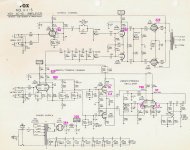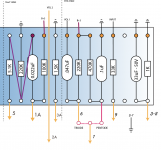Hi there!!,
I am building a single ended amp with a EF86 preamp. I want to place a 12ax7 after the EF86 but I am not sure how to proceed. I have a custom amp made by a US builder, and what he makes is to substitute the first triode of the 12ax7 and wire the rest as usual. He also places a 5.1K resistor between the output signal of the 12ax7 and the power tube. Therefore, this layout is mainly a vox ac4 adding half of a 12ax7.
What is the effect of the 12ax7 in this design?
Is this the usual way to place a 12ax7 after an Ef86?
Any idea on how to improve this design?
I have checked different layouts, such as the Route 66, several ceriatones and the VOX ac15, but none of them work in this way (indeed the look much more complicated).
Thanks and... CHEERS!
I am building a single ended amp with a EF86 preamp. I want to place a 12ax7 after the EF86 but I am not sure how to proceed. I have a custom amp made by a US builder, and what he makes is to substitute the first triode of the 12ax7 and wire the rest as usual. He also places a 5.1K resistor between the output signal of the 12ax7 and the power tube. Therefore, this layout is mainly a vox ac4 adding half of a 12ax7.
What is the effect of the 12ax7 in this design?
Is this the usual way to place a 12ax7 after an Ef86?
Any idea on how to improve this design?
I have checked different layouts, such as the Route 66, several ceriatones and the VOX ac15, but none of them work in this way (indeed the look much more complicated).
Thanks and... CHEERS!
You don´t "just place a 12AX7" there.
A 12AX7 has 2 triodes inside, each giving you a practical gain of about 50X , so if previously EF86 was enough to drive the power tube, with just one extra tride you have 50X more gain than before, and you turned your amplifier into a fuzz box.
Addf two, now extra gain added amounts to 2500X and your amp can pick radio transmissions across the Atlantic, or oscillate like crazy .
So I suggest you study commercial amplifier schematics, try to understand them step by styep and study whatever you don´t understand.
You´ll getb a good education on Guitar amplifier design.
There´s quite a lot of very good Tube amp books available, including some specifically on Musical Instrument amplifiers.
You won´t regret studying them 🙂
A 12AX7 has 2 triodes inside, each giving you a practical gain of about 50X , so if previously EF86 was enough to drive the power tube, with just one extra tride you have 50X more gain than before, and you turned your amplifier into a fuzz box.
Addf two, now extra gain added amounts to 2500X and your amp can pick radio transmissions across the Atlantic, or oscillate like crazy .
So I suggest you study commercial amplifier schematics, try to understand them step by styep and study whatever you don´t understand.
You´ll getb a good education on Guitar amplifier design.
There´s quite a lot of very good Tube amp books available, including some specifically on Musical Instrument amplifiers.
You won´t regret studying them 🙂
There is no "usual way". The 5.1K resistor sounds like a grid stopper, and not to offer significant attenuation.
Could you perhaps more plainly say what you are trying to achieve? You have this amp already, are you trying to build a copy of it or change some performance aspect of it?
Could you perhaps more plainly say what you are trying to achieve? You have this amp already, are you trying to build a copy of it or change some performance aspect of it?
I did something like that using a schematic from Doug. You reduce the gain of the EF86 in half and add the 12ax7. Check my build here http://https://www.diyaudio.com/forums/instruments-and-amps/311341-ef86-ac4-inspired-amplifier.html
The jack switching makes kind of complicated, but with this corcuit I could have different preamp configurations, from single triode after the EF86 to two triodes in a row, which gives some awesome distortion. The other two jacks switch between 12ax7 preamp or 12ax7 in parallel with the EF86.
The jack switching makes kind of complicated, but with this corcuit I could have different preamp configurations, from single triode after the EF86 to two triodes in a row, which gives some awesome distortion. The other two jacks switch between 12ax7 preamp or 12ax7 in parallel with the EF86.
Pii in the sky or have you a schematic you are working from.Hi there!!,
I am building a single ended amp with a EF86 preamp. I want to place a 12ax7 after the EF86 but I am not sure how to proceed. I have a custom amp made by a US builder, and what he makes is to substitute the first triode of the 12ax7 and wire the rest as usual. He also places a 5.1K resistor between the output signal of the 12ax7 and the power tube. Therefore, this layout is mainly a vox ac4 adding half of a 12ax7.
What is the effect of the 12ax7 in this design?
Is this the usual way to place a 12ax7 after an Ef86?
Any idea on how to improve this design?
I have checked different layouts, such as the Route 66, several ceriatones and the VOX ac15, but none of them work in this way (indeed the look much more complicated).
Thanks and... CHEERS!
The original Vox AC15 from 1960 used an EF86 in the high gain input feeding, through the tone and volume control, the ECC83 phase splitter, (you will note the pair of 100k anode load resistors, normally 100k and 91k now).
Nothing complicated about either schematics. One can get a gain approaching 100 from an ECC83, much more from an EF86. EL84s have 1k5 grid stoppers, not 5k1.
Have fun and be wary of high voltages.
Attachments
You don´t "just place a 12AX7" there.
A 12AX7 has 2 triodes inside, each giving you a practical gain of about 50X , so if previously EF86 was enough to drive the power tube, with just one extra tride you have 50X more gain than before, and you turned your amplifier into a fuzz box.
Addf two, now extra gain added amounts to 2500X and your amp can pick radio transmissions across the Atlantic, or oscillate like crazy .
So I suggest you study commercial amplifier schematics, try to understand them step by styep and study whatever you don´t understand.
You´ll getb a good education on Guitar amplifier design.
There´s quite a lot of very good Tube amp books available, including some specifically on Musical Instrument amplifiers.
You won´t regret studying them 🙂
There are some issues with the noise, as soon as I rise the volume there is some audible disturbance. Up to half way is unnoticiable, but after that, it becomes annoying. I thought it could be some bad fiter cap, but now I am not sure. Maybe picking some noise from elsewhere.
I attach the layout here, perhaps it might lead to improve the amp.
Attachments
- Status
- Not open for further replies.
- Home
- Live Sound
- Instruments and Amps
- EF86-12ax7 preamp question

